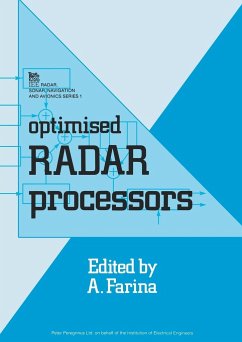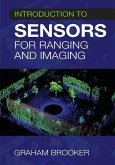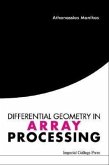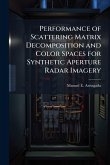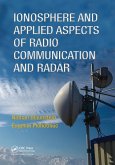Optimised Radar Processors
Herausgeber: Farina, A.
Optimised Radar Processors
Herausgeber: Farina, A.
- Broschiertes Buch
- Merkliste
- Auf die Merkliste
- Bewerten Bewerten
- Teilen
- Produkt teilen
- Produkterinnerung
- Produkterinnerung
This book is devoted to the description of optimum signal processing algorithms which can offer useful applications in radar systems.
Andere Kunden interessierten sich auch für
![Electronic Warfare and Radar Systems Engineering Handbook Electronic Warfare and Radar Systems Engineering Handbook]() Scott O'NeillElectronic Warfare and Radar Systems Engineering Handbook45,99 €
Scott O'NeillElectronic Warfare and Radar Systems Engineering Handbook45,99 €![Electromagnetic Compatibility Design Guide: For Avionics and Related Ground Support Equipment Electromagnetic Compatibility Design Guide: For Avionics and Related Ground Support Equipment]() Ernest R. FreemanElectromagnetic Compatibility Design Guide: For Avionics and Related Ground Support Equipment115,99 €
Ernest R. FreemanElectromagnetic Compatibility Design Guide: For Avionics and Related Ground Support Equipment115,99 €![Introduction to Sensors for Ranging and Imaging Introduction to Sensors for Ranging and Imaging]() Graham BrookerIntroduction to Sensors for Ranging and Imaging143,99 €
Graham BrookerIntroduction to Sensors for Ranging and Imaging143,99 €![Differential Geometry in Array Processing Differential Geometry in Array Processing]() Athanassios ManikasDifferential Geometry in Array Processing64,99 €
Athanassios ManikasDifferential Geometry in Array Processing64,99 €![Performance of Scattering Matrix Decomposition and Color Spaces for Synthetic Aperture Radar Imagery Performance of Scattering Matrix Decomposition and Color Spaces for Synthetic Aperture Radar Imagery]() Manuel E ArriagadaPerformance of Scattering Matrix Decomposition and Color Spaces for Synthetic Aperture Radar Imagery15,99 €
Manuel E ArriagadaPerformance of Scattering Matrix Decomposition and Color Spaces for Synthetic Aperture Radar Imagery15,99 €![Detectg Classifying Low Probability 2e Detectg Classifying Low Probability 2e]() Phillip E PaceDetectg Classifying Low Probability 2e161,99 €
Phillip E PaceDetectg Classifying Low Probability 2e161,99 €![Ionosphere and Applied Aspects of Radio Communication and Radar Ionosphere and Applied Aspects of Radio Communication and Radar]() Nathan BlaunsteinIonosphere and Applied Aspects of Radio Communication and Radar78,99 €
Nathan BlaunsteinIonosphere and Applied Aspects of Radio Communication and Radar78,99 €-
-
-
This book is devoted to the description of optimum signal processing algorithms which can offer useful applications in radar systems.
Produktdetails
- Produktdetails
- Radar, Sonar and Navigation
- Verlag: Institution of Engineering & Technology
- Seitenzahl: 212
- Erscheinungstermin: Juni 1987
- Englisch
- Abmessung: 297mm x 210mm x 11mm
- Gewicht: 564g
- ISBN-13: 9780863411182
- ISBN-10: 0863411185
- Artikelnr.: 50910802
- Herstellerkennzeichnung
- Libri GmbH
- Europaallee 1
- 36244 Bad Hersfeld
- gpsr@libri.de
- Radar, Sonar and Navigation
- Verlag: Institution of Engineering & Technology
- Seitenzahl: 212
- Erscheinungstermin: Juni 1987
- Englisch
- Abmessung: 297mm x 210mm x 11mm
- Gewicht: 564g
- ISBN-13: 9780863411182
- ISBN-10: 0863411185
- Artikelnr.: 50910802
- Herstellerkennzeichnung
- Libri GmbH
- Europaallee 1
- 36244 Bad Hersfeld
- gpsr@libri.de
* Part 1: Adaptive cancellation of clutter
* Chapter 1: Adaptive implementation of the optimum radar signal
processor
* Chapter 2: Application of Gram-Schmidt algorithm to optimum radar
signal processing
* Chapter 3: The Gram-Schmidt sidelobe canceller
* Chapter 4: Adaptive methods to implement the optimum radar signal
processor
* Chapter 5: The maximum entropy method and its application to clutter
cancellation
* Chapter 6: Performance comparison of optimum and conventional MTI and
Doppler processors
* Chapter 7: Radar detection of correlated targets in clutter
* Part 2: Detection theory for non-Gaussian distributed targets and
clutter signals
* Chapter 8: Coherent radar detection in log-normal clutter
* Chapter 9: Advanced models of targets, disturbances and related radar
signal processors
* Chapter 10: Radar detection of target signals in non- Gaussian
clutter: theory and applications
* Chapter 11: Theory of radar detection in coherent Weibull clutter
* Part 3: Detection for multistatic radar systems
* Chapter 12: Optimum and sub-optimum processors for multistatic radar
systems
* Chapter 13: Multistatic radar detection: synthesis and comparison of
optimum and sub-optimum receivers
* Chapter 14: Survey on multistatic radar detection
* Chapter 15: Multistatic detection of radar signals with Swerling
fluctuation type model
* Chapter 16: Overview of detection theory in multistatic radar
* Part 4: Techniques for surveillance radars
* Chapter 17: Surveillance radars: state of the art, research and
perspectives
* Chapter 18: A review of CFAR detection techniques in radar systems
* Chapter 19: Synthesis and evaluation of phase codes for pulse
compression radar
* Chapter 1: Adaptive implementation of the optimum radar signal
processor
* Chapter 2: Application of Gram-Schmidt algorithm to optimum radar
signal processing
* Chapter 3: The Gram-Schmidt sidelobe canceller
* Chapter 4: Adaptive methods to implement the optimum radar signal
processor
* Chapter 5: The maximum entropy method and its application to clutter
cancellation
* Chapter 6: Performance comparison of optimum and conventional MTI and
Doppler processors
* Chapter 7: Radar detection of correlated targets in clutter
* Part 2: Detection theory for non-Gaussian distributed targets and
clutter signals
* Chapter 8: Coherent radar detection in log-normal clutter
* Chapter 9: Advanced models of targets, disturbances and related radar
signal processors
* Chapter 10: Radar detection of target signals in non- Gaussian
clutter: theory and applications
* Chapter 11: Theory of radar detection in coherent Weibull clutter
* Part 3: Detection for multistatic radar systems
* Chapter 12: Optimum and sub-optimum processors for multistatic radar
systems
* Chapter 13: Multistatic radar detection: synthesis and comparison of
optimum and sub-optimum receivers
* Chapter 14: Survey on multistatic radar detection
* Chapter 15: Multistatic detection of radar signals with Swerling
fluctuation type model
* Chapter 16: Overview of detection theory in multistatic radar
* Part 4: Techniques for surveillance radars
* Chapter 17: Surveillance radars: state of the art, research and
perspectives
* Chapter 18: A review of CFAR detection techniques in radar systems
* Chapter 19: Synthesis and evaluation of phase codes for pulse
compression radar
* Part 1: Adaptive cancellation of clutter
* Chapter 1: Adaptive implementation of the optimum radar signal
processor
* Chapter 2: Application of Gram-Schmidt algorithm to optimum radar
signal processing
* Chapter 3: The Gram-Schmidt sidelobe canceller
* Chapter 4: Adaptive methods to implement the optimum radar signal
processor
* Chapter 5: The maximum entropy method and its application to clutter
cancellation
* Chapter 6: Performance comparison of optimum and conventional MTI and
Doppler processors
* Chapter 7: Radar detection of correlated targets in clutter
* Part 2: Detection theory for non-Gaussian distributed targets and
clutter signals
* Chapter 8: Coherent radar detection in log-normal clutter
* Chapter 9: Advanced models of targets, disturbances and related radar
signal processors
* Chapter 10: Radar detection of target signals in non- Gaussian
clutter: theory and applications
* Chapter 11: Theory of radar detection in coherent Weibull clutter
* Part 3: Detection for multistatic radar systems
* Chapter 12: Optimum and sub-optimum processors for multistatic radar
systems
* Chapter 13: Multistatic radar detection: synthesis and comparison of
optimum and sub-optimum receivers
* Chapter 14: Survey on multistatic radar detection
* Chapter 15: Multistatic detection of radar signals with Swerling
fluctuation type model
* Chapter 16: Overview of detection theory in multistatic radar
* Part 4: Techniques for surveillance radars
* Chapter 17: Surveillance radars: state of the art, research and
perspectives
* Chapter 18: A review of CFAR detection techniques in radar systems
* Chapter 19: Synthesis and evaluation of phase codes for pulse
compression radar
* Chapter 1: Adaptive implementation of the optimum radar signal
processor
* Chapter 2: Application of Gram-Schmidt algorithm to optimum radar
signal processing
* Chapter 3: The Gram-Schmidt sidelobe canceller
* Chapter 4: Adaptive methods to implement the optimum radar signal
processor
* Chapter 5: The maximum entropy method and its application to clutter
cancellation
* Chapter 6: Performance comparison of optimum and conventional MTI and
Doppler processors
* Chapter 7: Radar detection of correlated targets in clutter
* Part 2: Detection theory for non-Gaussian distributed targets and
clutter signals
* Chapter 8: Coherent radar detection in log-normal clutter
* Chapter 9: Advanced models of targets, disturbances and related radar
signal processors
* Chapter 10: Radar detection of target signals in non- Gaussian
clutter: theory and applications
* Chapter 11: Theory of radar detection in coherent Weibull clutter
* Part 3: Detection for multistatic radar systems
* Chapter 12: Optimum and sub-optimum processors for multistatic radar
systems
* Chapter 13: Multistatic radar detection: synthesis and comparison of
optimum and sub-optimum receivers
* Chapter 14: Survey on multistatic radar detection
* Chapter 15: Multistatic detection of radar signals with Swerling
fluctuation type model
* Chapter 16: Overview of detection theory in multistatic radar
* Part 4: Techniques for surveillance radars
* Chapter 17: Surveillance radars: state of the art, research and
perspectives
* Chapter 18: A review of CFAR detection techniques in radar systems
* Chapter 19: Synthesis and evaluation of phase codes for pulse
compression radar

